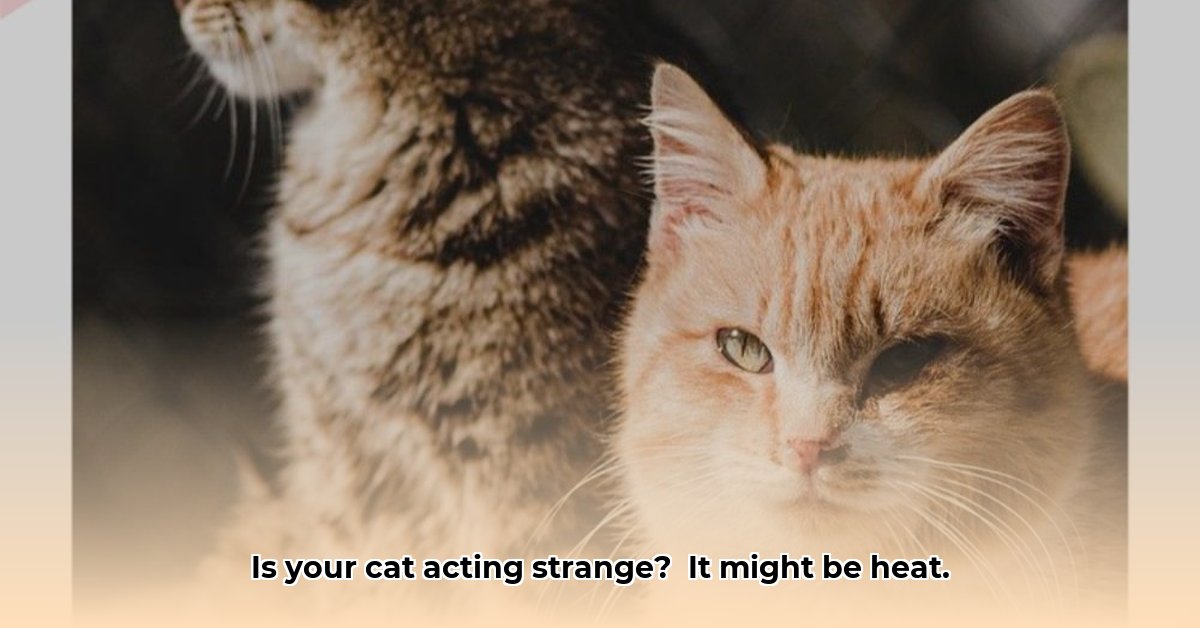Decoding Your Cat’s Behavior: Signs She’s in Heat
Notice your cat acting a little different? More vocal, clingy, or restless than usual? She might be in heat, a normal part of a female cat’s reproductive cycle also known as estrus. This guide helps you recognize the signs, understand what’s happening, and know how to best care for your kitty during this time.
The Soundtrack of Estrus: Vocalization Changes
One of the most telltale signs? A dramatic shift in vocalizations. Your usually quiet cat might start yowling, meowing loudly, or making other unusual sounds, especially at night. This is her way of advertising her availability to potential mates.
Affection Overload: Cuddling and Rolling
Is your independent kitty suddenly a cuddle monster, rubbing against everything and rolling around? This, combined with increased kneading, is another way she spreads her scent and signals her readiness to mate.
Body Language: Posture and Tail Talk
A key indicator is the “tail deflection reflex.” If you gently stroke your cat’s lower back and her tail moves to the side, exposing her hindquarters, it’s a strong sign of estrus. This posture facilitates mating. You might also observe her assuming a “lordosis” posture—lowered front body, raised rear, and tail deflected.
Restlessness and Escape Artistry
A sudden urge to roam, especially in indoor cats, can suggest she’s in heat. This restlessness might involve pacing, trying to escape outdoors, or constantly patrolling near doors and windows.
Physical Signs: Subtle but Important
While behavioral changes are usually more obvious, some physical changes might occur. Her vulva may appear slightly swollen. Importantly, cats do not bleed during heat. Any bloody discharge warrants a vet visit.
The Feline Reproductive Cycle: A Quick Overview
Cats are “polyestrous,” meaning they can have multiple heat cycles throughout the year, especially if exposed to consistent artificial light. Each cycle lasts a few days to a week or longer.
Understanding the Phases
| Stage | What’s Happening |
|---|---|
| Proestrus | The very beginning; hormonal changes start, but behavioral signs are minimal. |
| Estrus | The main “heat” period; you’ll see the most prominent behavioral changes. |
| Interestrus | The period between cycles; a time of hormonal calm if mating doesn’t occur. |
| Diestrus | Post-mating; can lead to pregnancy or a pseudo-pregnancy. |
| Anestrus | Reproductive inactivity, typical during colder months (though can vary). |
What to Do If Your Cat Is in Heat
- Keep Her Indoors: This prevents unwanted pregnancies and protects her from outdoor dangers.
- Consult Your Vet: If the heat cycle is unusually long, intense, or if anything seems off, seek professional advice.
- Consider Spaying/Neutering: This is the most responsible approach, offering health and behavioral benefits while preventing pet overpopulation.
FAQs: Common Questions About Feline Heat
- How long does a cat stay in heat? Typically 4-10 days, but it can vary from a few days up to two weeks. Factors like breed, age, and individual differences play a role. Ongoing research explores how genetics and environment might also influence heat cycle duration.
- How often do cats go into heat? Cats can cycle every few weeks during breeding season (typically spring and summer). In warmer climates or with consistent indoor lighting, some cats may cycle year-round. The frequency can vary considerably between individual cats.
- Can a spayed cat still show signs of heat? It’s rare, but sometimes, spayed cats might display behaviors similar to heat if a small amount of ovarian tissue remains after surgery. If this happens, consult your veterinarian.
- Is being in heat painful for cats? While not typically painful, being in heat can be uncomfortable and frustrating. Imagine it like feeling a persistent urge you can’t satisfy.
- Is increased urination a sign of being in heat? While some scent marking (urine spraying) can occur, frequent urination is more likely a sign of a urinary tract infection. If you see this, consult your vet.
Debunking Myths and Misconceptions
One common misconception is that increased urination is a direct symptom of heat. While scent marking can happen, frequent urination is more indicative of a urinary tract infection. Another myth is that being in heat is excruciatingly painful. While it likely causes some discomfort and frustration, it’s not considered intensely painful. These nuances highlight the importance of accurate information, especially when interpreting feline behavior.
Caring for Your Cat During Estrus
Beyond the essentials of keeping her indoors and consulting your vet, some additional steps can help your cat through her heat cycle:
- Create a Calming Environment: Minimize stress with a quiet, safe space. Pheromone diffusers or sprays might provide some comfort.
- Offer Distractions: Engaging toys, puzzle feeders, or even a new scratching post can help redirect her energy and reduce restlessness.
- Consider Catnip: Catnip can have a calming effect on some cats, offering temporary relief from the urges of estrus.
- Provide Extra Attention (If She Wants It): While some cats become more clingy, others prefer to be left alone. Follow her lead and respect her preferences.
Spaying: A Long-Term Solution
Spaying is a surgical procedure that removes a female cat’s reproductive organs. While it requires anesthesia and surgery, spaying offers significant benefits:
- Eliminates Heat Cycles: No more yowling, restlessness, or unwanted attention-seeking behaviors.
- Prevents Unwanted Pregnancies: Contributes to controlling pet overpopulation.
- Reduces the Risk of Certain Diseases: Significantly lowers the risk of uterine infections and mammary tumors.
While spaying offers many pros, it’s essential to discuss it with your vet to understand the procedure, benefits, potential risks, and post-operative care.
This guide offers a starting point for recognizing signs of estrus in your feline friend. Importantly, every cat is different, and their experience with heat can vary. If you have any concerns about your cat’s behavior or health, consulting a veterinarian is always the best course of action. They can offer personalized advice tailored to your cat’s specific needs. As research continues, our understanding of feline reproductive health evolves, reinforcing the importance of staying informed and seeking professional guidance when needed.
- Find Premium Personal Growth Clipart Now: Boost Your Content - October 19, 2025
- Unlock Your Potential: Top Personal Growth Blogs 2024 - October 16, 2025
- Discover Unforgettable Yachting Experiences for Personal Growth: Transform Your Life at Sea - October 14, 2025
















